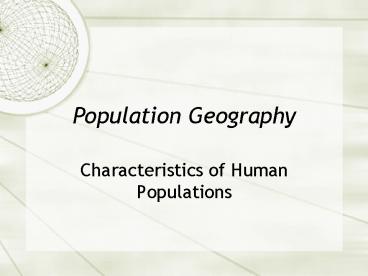Population Geography - PowerPoint PPT Presentation
1 / 35
Title:
Population Geography
Description:
Population Geography Characteristics of Human Populations Cool video about population Population Geography The Joy of Statistics! Han Rosling Human populations around ... – PowerPoint PPT presentation
Number of Views:158
Avg rating:3.0/5.0
Title: Population Geography
1
Population Geography
- Characteristics of Human Populations
2
Population Geography
- The Joy of Statistics! Han Rosling
3
- Human populations around the world differ by
densities, distributions, ethnicities, languages,
religions, and other factors. Imagine traveling
to China and then to Northern Canada. How might
the populations vary in these areas?
4
World Population
- World Population Clock
5
How do Geographers Compare Populations?
- Birth and Death Rates
- Age Distribution
- Male/Female Distribution
- Life Expectancy
- Infant Mortality
- Urban/Rural
6
- Gross Domestic Product
- Ethnicity
- Language
- Religion
- Level of Education
7
Birth and Death Rates
- Birth and death rates refer to how many people
are born and how many people die. Developing
countries have high death rates and birth rates.
8
Birth and Death Rates
- Birth rates are higher in developing countries
for the following reasons - No birth control
- Religious restrictions
- Economic factors
- The role of women in society
9
Birth and Death Rates
- Death rates are higher in developing countries
for the following reasons - No access to medical care
- Poor nutrition
10
(No Transcript)
11
Age Distribution
- Age distribution refers to the number of young
people compared to older people in a given
population.
12
Age Distribution
- Developed countries, such as the United States,
Canada, and most of Europe have an aging
population. This happens when people are having
fewer children and living longer. This
translates to a shortage of laborers.
13
(No Transcript)
14
(No Transcript)
15
Population Pyramids Video
16
Pyramid Shape
Stage 1
High birth rates and high death rates with little
or no population growth
High birth rates and lower death rates with
increase in total population
Stage 2
Lower birth rates and lower death rates with
decrease in slowed growth in total population
Stage 3
Low birth rates and low death rates with very
slow or negative population growth
Stage 4
17
18
Male/Female Distribution
- This is self explanatory. Some areas have an
imbalanced male/female distribution. A good
example is when settlers first came to Jamestown.
For many years the colony had more males than
females.
19
Male/Female Distribution
- China has a one child policy. Families are
restricted to having one child or they face
penalties imposed by the government. This led to
female infanticide or the killing of girl infants.
20
Life Expectancy
- Life expectancy is how long a person will live.
Life expectancy is longer in developed countries,
mainly due to better medical care.
Statistically, women live longer than men.
21
(No Transcript)
22
Infant Mortality
- Infant mortality is the number of babies that die
at birth. This number is usually per every 1,000
people in a population.
23
Infant Mortality
- Infant mortality is very high in developing
countries. For instance, some African countries
have an infant mortality rate that is over 10.
24
(No Transcript)
25
Urban/Rural Ratio
- The urban/rural ratio is the number of people who
live in the countryside versus the city.
Countries like Japan, Singapore, and Korea have
many more people who live in large cities than
the countryside.
26
Urban/Rural Ratio
- Over the last 100 years people have been
migrating to large cities in the United States.
Our population is becoming more urban.
27
Gross Domestic Product
- GDP is the total of all goods and services
produced in a country in one year. Developing
countries and poor populations have a low GDP.
28
(No Transcript)
29
Ethnicity
- Ethnicity was defined during the unit on culture.
Obviously, different populations around the
world have different ethnic compositions.
30
Ethnicity
- The ethnicity of the United States is relatively
diverse because the United States is composed of
immigrants while Japan has a homogeneous
population.
31
Language
- Different populations speak different languages.
English and Spanish are the two most spoken
languages in the United States, but countries
like Nigeria have over 200 spoken languages.
32
Religion
- Two different populations may follow different
religions. Protestant Christianity is the
largest religion in the United States while
Hinduism is the main religion in India.
33
Education
- The level of education differs between
populations. Developing countries normally have
poor education systems or children do not have
the opportunity to go to school.
34
(No Transcript)
35
Cool video about population

